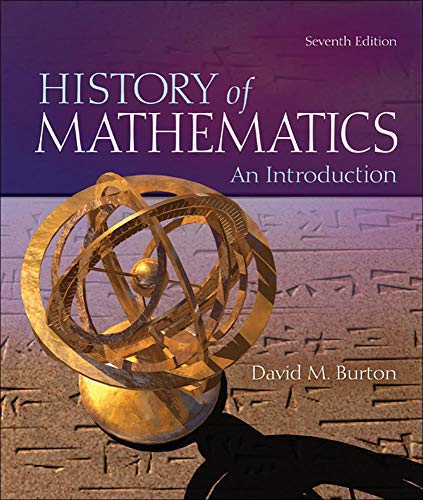Copies of the classnotes are on the internet in PDF format as given below. The notes and supplements may contain hyperlinks to posted webpages; the links appear in red fonts. The "Examples, Exercises, and Proofs" files were prepared in Beamer. The "Printout of Examples, Exercises, and Proofs" are printable PDF files of the Beamer slides without the pauses. These notes have not been classroom tested and may have typographical errors.
The catalog description for History of Mathematics is: "A study of mathematics and those who contributed to its development. Recommended for teachers and those desiring to expand their view of mathematics." The prerequisites are Linear Algebra (MATH 2010), Calculus 3 (MATH 2110), and Mathematical Reasoning (MATH 3000).
With an eye on the highschool math curriculum, we concentrate on four topics: (1) numbers, (2) geometry, (3) equations and algebra, and (time permitting) (4) calculus.
1. Early Number Systems and Symbols.
- 1.1. Primitive Counting.
- 1.2. Number Recording of the Egyptians and Greeks.
- 1.3. Number Recording of the Bablyonians.
2. Mathematics in Early Civilizations.
- 2.1. The Rhind Papyrus.
- 2.2. Egyptian Arithmetic.
- 2.3. Four Problems from the Rhind Papyrus.
- 2.4. Egyptian Geometry.
- 2.5. Babylonian Mathematics.
- 2.6. Plimpton 322.
3. The Beginnings of Greek Mathematics.
- 3.1. The Geometrical Discoveries of Thales.
- 3.2. Pythagorean Mathematics.
- 3.3. The Pythagorean Problem.
- 3.4. Three Construction Problems in Antiquity.
- 3.5. The Quadratrix of Hippias.
4. The Alexandrian School: Euclid.
- 4.1. Euclid and the Elements.
- 4.2. Euclidean Geometry.
- 4.3. Euclid's Number Theory.
- 4.4. Erotosthenes, the Wise Man of Alexandria.
- 4.5. Archimedes.
5. The Twilight of Greek Mathematics.
- 5.1. The Decline of Alexandrian Mathematics.
- 5.2. The Arithmetica.
- 5.3. Diophantine Equations in Greece, India, and China.
- 5.4. The Latest Commentators.
- 5.5. Mathematics in the Near and Far East.
6. The First Awakening: Fibonacci.
- 6.1. The Decline and Revival of Learning.
- 6.2. The and Liber Quadratorum.
- 6.3. The Fibonacci Sequence.
- 6.4. Fibonacci and the Pythagorean Problem.
7. The Renaissance of Mathematics World: Cardan and Tartaglia.
- 7.1. Europe in the Fourteenth and Fifteenth.
- 7.2. The Battle of the Scholars.
- 7.3. Cardan's Ars Magna .
- 7.4. Ferrari's Solution of the Quartic Equation.
8. The Mechanical World: Descartes and Newton.
- 8.1. The Dawn of Modern Mathematics.
- 8.2. Descartes: The Discours de la Méthode.
- 8.3. Newton: The Principia Mathematica.
- 8.4. Gottfried Leibniz: The Calculus Controversy.
9. The Development of Probability Theory: Pascal, Bernoulli, and Laplace.
- 9.1. The Origins of Probability Theory.
- 9.2. Pascal's Arithmetic Triangle.
- 9.3. The Bernoullis and Laplace.
10. The Revival of Number Theory: Fermat, Euler, and Gauss.
- 10.1. Marin Mersenne and the Search for Perfect Numbers.
- 10.2. From Termat to Euler.
- 10.3. The Prince of Mathematicians: Carl Friedrich Gauss.
11. Nineteenth-Century Contributions: Lobachevsky to Hilbert.
- 11.1. Attempts to Prove the Parallel Postulate.
- 11.2. The Founders of Non-Euclidean Geometry.
- 11.3. The Age of Rigor.
- 11.4. Arithmetic Generalized.
12. Transition to the Twentieth Century: Cantor and Kronecker.
- 12.1. The Emergence of American Mathematics.
- 12.2. Counting the Infinite.
- 12.3. The Paradoxes of Set Theory.
13. Extensions and Generalizations: Hardy, Hausdorff, and Noether.
- 13.1. Hardy and Ramanujan.
- 13.2. The Beginnings of Point-Set Topology.
- 13.3. Some Twentieth-Century Developments.
Return to Bob Gardner's home page

